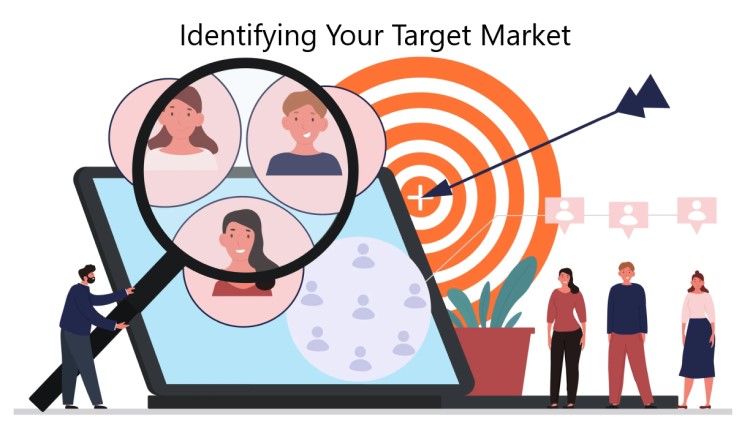
Understanding the Importance of a Target Market
Identifying your target market is crucial for business success because it ensures you focus on the right customers. By understanding who your ideal customers are, you can develop products and services that meet their specific needs. This focus allows businesses to allocate resources effectively, avoiding wasted efforts on broad, unfocused strategies. Without a clear target market, businesses risk creating products that don’t resonate with anyone, leading to missed opportunities and lower profitability.
Identifying your target market also has a direct impact on marketing strategies. When you know who your customers are, you can tailor your messaging, advertising, and promotions to address their preferences and pain points. This personalized approach improves the effectiveness of your marketing efforts, increasing the likelihood of customer engagement and conversions. Moreover, targeting the right audience leads to better customer retention since your offerings align with their needs, building loyalty and trust.
In product development, having a well-defined target market ensures that you’re designing solutions that solve real problems for your audience. Businesses that understand their market can innovate with purpose, developing features or services that drive customer satisfaction and long-term growth. Identifying your target market from the start helps align your entire business strategy, driving efficiency, improving customer experiences, and boosting overall success.
Demographic Segmentation
Demographic segmentation is one of the most effective ways to narrow down your ideal customer profile. It involves analyzing factors like age, gender, income, education, and occupation to better understand your target audience. These demographic elements provide valuable insights into consumer behavior and purchasing patterns. For example, younger consumers may prefer online shopping and social media marketing, while older generations may respond better to traditional advertising.
By using demographic data, businesses can identify the specific segments of the population most likely to be interested in their products or services. For instance, luxury brands may focus on high-income earners, while educational products might target individuals with higher levels of formal education. This detailed understanding allows businesses to create more tailored offerings and marketing messages, increasing the likelihood of converting prospects into customers.
Demographic segmentation plays a crucial role in identifying your target market because it helps refine your customer base. Instead of adopting a one-size-fits-all approach, you can focus on the segments most relevant to your business. This ensures that your marketing and product development efforts are aligned with the needs and preferences of your ideal customers, driving higher engagement and stronger results.
Psychographic and Behavioral Analysis
Psychographic and behavioral analysis focuses on understanding customers’ interests, lifestyles, values, and buying behaviors. This deeper level of analysis helps businesses gain insight into the emotional and psychological factors that drive purchasing decisions. By identifying customers’ attitudes, hobbies, and values, businesses can craft messages and products that resonate on a personal level, improving the chances of customer engagement and loyalty.
This type of analysis plays a crucial role in product positioning. When you understand your target market’s lifestyle and values, you can position your product in a way that aligns with their needs and desires. For example, if your target market values sustainability, highlighting eco-friendly features in your messaging can create a strong connection with those customers. Similarly, understanding buying behavior, such as impulse buying or planned purchases, allows businesses to optimize their sales strategies and timing.
Incorporating psychographic and behavioral data is essential when **identifying your target market** because it helps you move beyond demographics and engage with your customers more effectively. This analysis leads to more tailored marketing efforts, from content creation to social media engagement, and ensures that your messaging speaks directly to the heart of your audience. Ultimately, by understanding the “why” behind your customers’ actions, you can deliver more meaningful experiences and foster deeper connections with your target market.
Market Research Methods to Identify Your Target Market
Effective market research methods are essential when identifying your target market. Surveys are a popular tool for gathering data directly from your audience. By asking specific questions, businesses can gain valuable insights into customer preferences, behaviors, and expectations. Focus groups offer another method for exploring consumer attitudes in a more interactive setting, allowing participants to discuss their thoughts and experiences in detail. Customer feedback, whether through online reviews or post-purchase surveys, also provides essential insights into what customers value and how they perceive your product or service.
Social media platforms are valuable resources for identifying your target market as well. Businesses can analyze audience interactions, comments, and shares to better understand customer interests and behaviors. Social media analytics tools provide detailed data on engagement, demographics, and preferences, helping you identify key trends and tailor your marketing strategies accordingly. Additionally, leveraging tools like Google Analytics can offer insights into website visitor behavior, showing what content attracts attention and which products or services are most popular.
Combining these market research methods helps ensure a well-rounded approach to identifying your target market. Surveys, focus groups, and customer feedback provide direct input from customers. Social media and analytics offer a broader view of audience behavior. Together, these tools allow businesses to make data-driven decisions. This ensures that their marketing strategies and product offerings align with the needs and preferences of their ideal customers.
Refining and Evolving Your Target Market
As businesses grow or expand, refining and evolving their target market becomes essential for continued success. Initially, a company may focus on a specific demographic. However, as they introduce new products or enter different markets, they may need to adjust their target audience. Identifying your target market should be an ongoing process. This allows companies to stay aligned with changing customer needs and industry trends. By continuously analyzing market conditions and customer preferences, businesses can better position themselves for long-term growth.
Using customer data is critical for refining your marketing strategies. Analyzing feedback, purchase behaviors, and engagement metrics allows businesses to gain insights into shifting consumer interests. This data can reveal opportunities for expanding into new segments or adjusting product offerings to meet evolving needs. For example, a product that initially appealed to younger consumers may later attract an older demographic. This requires a change in messaging and marketing tactics.
Incorporating regular assessments of customer data ensures that businesses remain flexible and adaptable. By tracking trends, businesses can anticipate changes in the market and proactively adjust their strategies. Identifying your target market isn’t a one-time activity. It’s an ongoing effort to ensure marketing, product development, and customer engagement remain relevant and effective in a dynamic marketplace.
Conclusion
In conclusion, identifying your target market is essential for business success. It allows companies to focus their efforts on the right audience. This ensures that their products and marketing strategies resonate with customers. By analyzing demographics, psychographics, and customer behavior, businesses can develop more effective campaigns and products that meet specific needs. As your business grows, continually refining and adapting your target market ensures long-term relevance and success. In today’s competitive landscape, identifying your target market is a key driver of growth, profitability, and also customer satisfaction.


